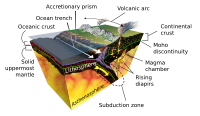
Photo from wikipedia
Abstract Sedimentary diapirs can be relaminated to the base of the lithosphere during slab subduction, where they can interact with the ambient lithospheric mantle to form variably metasomatized zones. Here,… Click to show full abstract
Abstract Sedimentary diapirs can be relaminated to the base of the lithosphere during slab subduction, where they can interact with the ambient lithospheric mantle to form variably metasomatized zones. Here, high-pressure experiments in sediment-harzburgite systems were conducted at 1.5–2.5 GPa and 800–1300 °C to investigate the interaction between relaminated sediment diapirs and lithospheric mantle. Two end-member processes of mixed experiments and layered (reaction) experiments were explored. In the first end-member, sediment and harzburgite powders were mixed to a homogeneous proportion (1:3), whereas in the second, the two powders were juxtaposed as separate layers. In the first series of experiments, the run products were mainly composed of olivine + orthopyroxene + clinopyroxene + phlogopite in subsolidus experiments, while the phase assemblages were then replaced by olivine + orthopyroxene + melt (or trace phlogopite) in supersolidus experiments. Basaltic and foiditic melts were observed in all supersolidus mixed experiments (~44–52 wt% SiO2 at 1.5 GPa, ~35–43 wt% SiO2 at 2.5 GPa). In the phlogopite-rich experiment (PC431, 1.5 GPa and 1100 °C), the formed melts had low alkali contents (~<2 wt%) and K2O/Na2O ratios (~0.4–1.1). In contrast, the quenched melt in phlogopite-free/poor experiments showed relatively higher alkali contents (~4–8 wt%) and K2O/Na2O ratios (~2–5). Therefore, the stability of phlogopite could control the bulk K2O and K2O/Na2O ratios of magmas derived from the sediment-metasomatized lithospheric mantle. In layered experiments, a reaction zone dominated by clinopyroxene + amphibole (or orthopyroxene) was formed because of the reaction between harzburgite and bottom sediment-derived melts (~62.5–67 wt% SiO2). The total alkali contents and K2O/Na2O ratios of the formed melts were about 6–8 wt% and 1.5–3, respectively. Experimentally formed melts from both mixed and reaction experiments were rich in large ion lithosphile elements and displayed similar patterns with natural potassium-rich arc lavas from oceanic subduction zones (i.e., Mexican, Sunda, Central American, and Aleutian). The experimental results demonstrated that bulk sediment diapirs, in addition to sediment melt, may be another possible mechanism to transfer material from a subducting slab to an upper mantle wedge or lithospheric mantle. On the other hand, the breakdown of phlogopite may play an important role in the mantle source that produces potassiumrich arc lavas in subduction zones.
Journal Title: American Mineralogist
Year Published: 2020
Link to full text (if available)
Share on Social Media: Sign Up to like & get
recommendations!